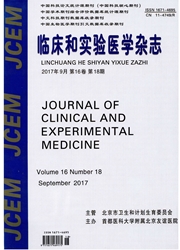

 中文摘要:
中文摘要:
目的探讨脑卒中后抑郁与脑梗死部位及血浆同型半胱氨酸的关系。方法选择262例脑卒中患者为研究对象,采用汉密尔顿抑郁量表(HAMD)评估患者抑郁严重程度,采用荧光偏振免疫分析(FPIA)检测血清同型半胱氨酸水平。结果262例患者中确诊卒中后抑郁患者120例,发生率为45.8%。抑郁组患者与非抑郁组患者左侧卒中发生率分别为51.7%和52.1%,差异无统计学意义(P〉0.05);抑郁组患者梗死灶位于皮质者比例显著高于非抑郁组患者(63.3%VS.33.8%,P〈0.05);抑郁组前部病灶比率显著升高(66.7%VS.22.5%,P〈0.05);在轻度、中度及重度抑郁患者中,血清同型半胱氨酸水平逐渐升高,差异具有统计学意义(P〈0.05)。结论脑卒中后抑郁的发生与患者脑梗死部位关系密切。同型半胱氨酸水平与患者病情严重程度密切相关。
 英文摘要:
英文摘要:
Objective To explore the relationship between location of brain infarction, and serum level of homocysteine in patients with post - stroke depression. Methods Two hundred and sixty - two cases with cerebral stroke were selected as subjects for study. Hamilton Depres- sion scale (HAMD) had been applied to evaluate the severity of depression, and fluorescence polarization immunoassay (FPIA) was used to meas- ure serum level of homocysteine. Results Among 262 patients, 120 cases were diagnosed as post - stroke depression with incidence rate of 45. 8%. The occurrence rates of left part lesion in depression patients and patients without depression were 51.7% and 52.1% respectively, and there was no significant difference between them ( P 〉 0.05). The incidence rate of cortex infarction in depression patients was much higher than that of patients without depression ( 63.3 % vs. 33.8 %, P 〈 0.05 ). In comparison with patients without depression, the incidence rate of anteri- or lesions in depression patients was greatly increased (66.7% vs. 22.5% , P 〈 O. 05 ). Serum level of homocysteine had been gradually in- creased in patients with mild, moderate and severe depression with significant difference ( P 〈 0.05 ). Conclusion The occurrence of post - stroke depression has close relationship with locality of infarction. Serum level of homoevsteine is closely related to the severity of deoression.
 同期刊论文项目
同期刊论文项目
 同项目期刊论文
同项目期刊论文
 期刊信息
期刊信息
